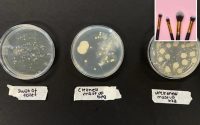‘Forever’ chemicals linked to liver cancer in first human study
There’s growing evidence that regular exposure to man-made “forever” chemicals, which are used in a variety of household products, are linked to rising cancer rates.
A new study that examined the correlation between liver cancer and the presence of these chemicals in humans found that people with the highest levels of exposure have 350% greater odds of eventually developing the disease.
The term “forever” chemicals refers to the more than 4,700 available types of perfluoroalkyl and polyfluoroalkyl substances, or PFAS, used widely across manufacturing industries — named as such because the substances degrade very slowly and build up over time, in soil, drinking water and in the body.
PFAS were first introduced in the 1930s as a revolutionary material used in the creation of nonstick cookware — hello, Teflon — and soon adapted to all sorts of products and packaging — from construction materials to cosmetics — that benefit from its liquid- and fire-resistant properties, as noted by the Centers for Disease Control and Prevention.


Though incredibly useful, such chemicals have since been linked to the onset of cancer and other illnesses in lab animals. Following strong anecdotal evidence that perfluorooctanesulfonic acids (PFOS) alongside another common substance called perfluorooctanoic acid (PFOA) were making consumers sick, the Environmental Protection Agency in 2006 ordered eight multinational manufacturing corporations represented in the US to phase out the use of such chemicals. Nevertheless, as their nickname implies, PFOS and PFOA are still being detected in foreign products, in groundwater and in people.
The current study, published in JHEP Reports, is the first to show a clear association between any PFAS and nonviral hepatocellular carcinoma (the most common type of liver cancer) in humans, too.
“This builds on the existing research, but takes it one step further,” said Jesse Goodrich, a postdoctoral public health researcher at Keck School of Medicine, in a University of Southern California news release. “Liver cancer is one of the most serious endpoints in liver disease and this is the first study in humans to show that PFAS are associated with this disease.”
Showing an association between PFAS and cancer in humans hasn’t been easy for scientists.
“Part of the reason there has been few human studies is because you need the right samples,” added Keck School of Medicine professor Veronica Wendy Setiawan. “When you are looking at an environmental exposure, you need samples from well before a diagnosis because it takes time for cancer to develop.”
To make this leap, researchers were given access to the Multiethnic Cohort Study database, which entails a survey of cancer development in more than 200,000 residents of Hawaii as well as Los Angeles, Calif., conducted by the University of Hawaii.
Their search was narrowed to 100 survey participants — 50 of them with liver cancer and 50 without — whose available blood and tissue samples were sufficient for analysis. Researchers were looking for traces of “forever” chemicals present in the body before the group with cancer became ill.
They reportedly found several types of PFAS among participants, with PFOS appearing most prominently among those in the group with liver cancer. Indeed, their investigation revealed that those who fell in the top 10% of PFOS exposure were 4.5 times more likely to develop hepatocellular carcinoma when compared to those with the least exposure.
The clear link between PFAS and cancer in humans is crucial to further study on how these chemicals interfere with biological processes. Per the current findings, USC scientists now believe that high concentrations of PFOS in some subjects had impaired the liver’s ability to metabolize glucose, bile acid and branched-chain amino acids, resulting in unhealthy levels of fat accumulation in the organ, otherwise known as nonalcoholic fatty liver disease — a high-risk factor for liver cancer.
That’s why many scientists agree it’s no coincidence that the advent and widespread use of “forever” chemicals correlates with a rise in liver disease, cancer and other illnesses.
“We believe our work is providing important insights into the long-term health effects that these chemicals have on human health, especially with respect to how they can damage normal liver function,” said study author Dr. Leda Chatzi. “This study fills an important gap in our understanding of the true consequences of exposure to these chemicals.”


